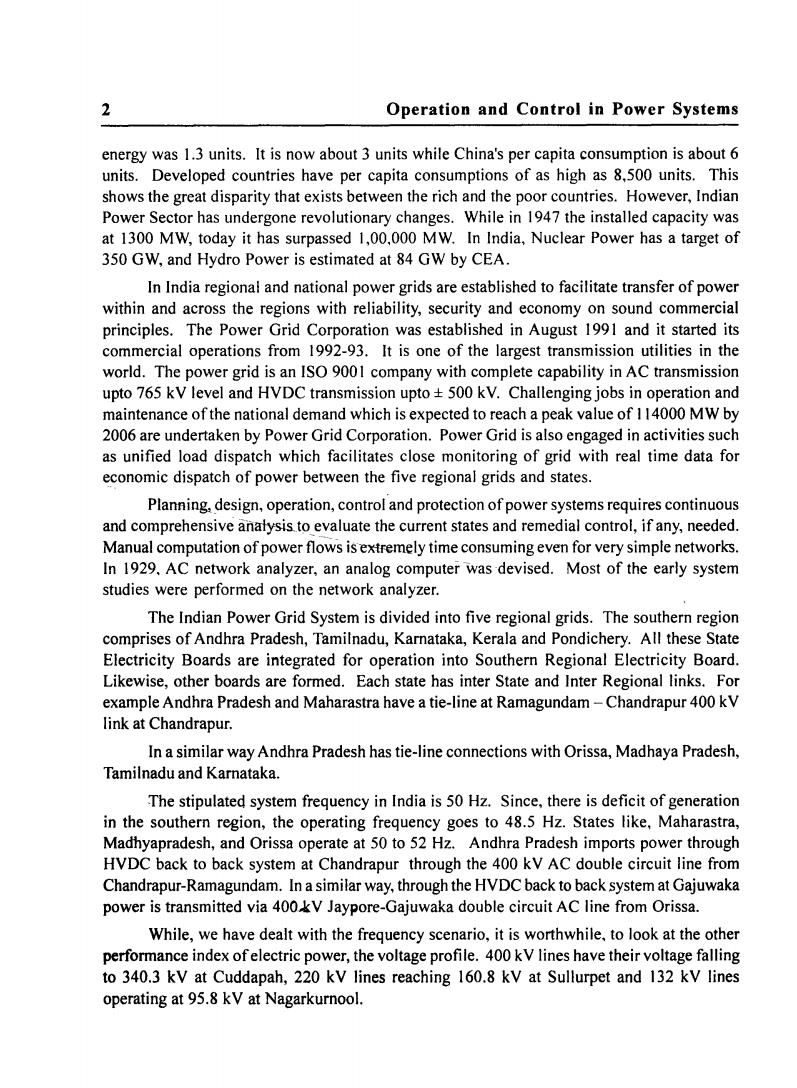
2 Operation and Control in Power Systems energy was 1.3 units.It is now about 3 units while China's per capita consumption is about 6 units.Developed countries have per capita consumptions of as high as 8,500 units.This shows the great disparity that exists between the rich and the poor countries.However,Indian Power Sector has undergone revolutionary changes.While in 1947 the installed capacity was at 1300 MW,today it has surpassed 1,00,000 MW.In India,Nuclear Power has a target of 350 GW,and Hydro Power is estimated at 84 GW by CEA. In India regional and national power grids are established to facilitate transfer of power within and across the regions with reliability,security and economy on sound commercial principles.The Power Grid Corporation was established in August 1991 and it started its commercial operations from 1992-93.It is one of the largest transmission utilities in the world.The power grid is an ISO 9001 company with complete capability in AC transmission upto 765 kV level and HVDC transmission upto+500 kV.Challenging jobs in operation and maintenance of the national demand which is expected to reach a peak value of 1 14000 MW by 2006 are undertaken by Power Grid Corporation.Power Grid is also engaged in activities such as unified load dispatch which facilitates close monitoring of grid with real time data for economic dispatch of power between the five regional grids and states. Planning,design,operation,control and protection of power systems requires continuous and comprehensive analysis to evaluate the current states and remedial control,if any,needed. Manual computation of power flows is extremely time consuming even for very simple networks. In 1929.AC network analyzer,an analog computer was devised.Most of the early system studies were performed on the network analyzer. The Indian Power Grid System is divided into five regional grids.The southern region comprises of Andhra Pradesh,Tamilnadu,Karnataka,Kerala and Pondichery.All these State Electricity Boards are integrated for operation into Southern Regional Electricity Board. Likewise,other boards are formed.Each state has inter State and Inter Regional links.For example Andhra Pradesh and Maharastra have a tie-line at Ramagundam-Chandrapur 400 kV link at Chandrapur. In a similar way Andhra Pradesh has tie-line connections with Orissa,Madhaya Pradesh, Tamilnadu and Karnataka. The stipulated system frequency in India is 50 Hz.Since,there is deficit of generation in the southern region,the operating frequency goes to 48.5 Hz.States like,Maharastra, Madhyapradesh,and Orissa operate at 50 to 52 Hz.Andhra Pradesh imports power through HVDC back to back system at Chandrapur through the 400 kV AC double circuit line from Chandrapur-Ramagundam.In a similar way,through the HVDC back to back system at Gajuwaka power is transmitted via 400kV Jaypore-Gajuwaka double circuit AC line from Orissa. While,we have dealt with the frequency scenario,it is worthwhile,to look at the other performance index of electric power,the voltage profile.400 kV lines have their voltage falling to 340.3 kV at Cuddapah,220 kV lines reaching 160.8 kV at Sullurpet and 132 kV lines operating at 95.8 kV at Nagarkurnool
2 Operation and Control in Power Systems energy was 1.3 units. It is now about 3 units while China's per capita consumption is about 6 units. Developed countries have per capita consumptions of as high as 8,500 units. This shows the great disparity that exists between the rich and the poor countries. However, Indian Power Sector has undergone revolutionary changes. While in 1947 the installed capacity was at 1300 MW, today it has surpassed 1,00,000 MW. In India, Nuclear Power has a target of 350 GW, and Hydro Power is estimated at 84 GW by CEA. In India regional and national power grids are established to facilitate transfer of power within and across the regions with reliability, security and economy on sound commercial principles. The Power Grid Corporation was established in August 1991 and it started its commercial operations from 1992-93. It is one of the largest transmission utilities in the world. The power grid is an ISO 9001 company with complete capability in AC transmission upto 765 kV level and HVDC transmission upto ± 500 kV. Challenging jobs in operation and maintenance of the national demand which is expected to reach a peak value of 114000 MW by 2006 are undertaken by Power Grid Corporation. Power Grid is also engaged in activities such as unified load dispatch which facilitates close monitoring of grid with real time data for economic dispatch of power between the five regional grids and states. Planning,design, operation, control and protection of power systems requires continuous and comprehensive anatysisJo_e~aluate the current states and remedial control, if any, needed. Manual computation of power flows isexrremely time consuming even for very simple networks. In 1929, AC network analyzer, an analog computer was devised. Most of the early system studies were performed on the network analyzer. The Indian Power Grid System is divided into five regional grids. The southern region comprises of Andhra Pradesh, Tamilnadu, Karnataka, Kerala and Pondichery. All these State Electricity Boards are integrated for operation into Southern Regional Electricity Board. Likewise, other boards are formed. Each state has inter State and Inter Regional links. For example Andhra Pradesh and Maharastra have a tie-line at Ramagundam - Chandrapur 400 kV link at Chandrapur. In a similar way Andhra Pradesh has tie-line connections with Orissa, Madhaya Pradesh, Tamilnadu and Karnataka. The stipulated system frequency in India is 50 Hz. Since, there is deficit of generation in the southern region, the operating frequency goes to 48.5 Hz. States like, Maharastra, Madhyapradesh, and Orissa operate at 50 to 52 Hz. Andhra Pradesh imports power through HVDC back to back system at Chandrapur through the 400 kV AC double circuit line from Chandrapur-Ramagundam. In a similar way, through the HVDC back to back system at Gajuwaka power is transmitted via 400..kV Jaypore-Gajuwaka double circuit AC line from Orissa. While, we have dealt with the frequency scenario, it is worthwhile, to look at the other performance index of electric power, the voltage profile. 400 kV lines have their voltage falling to 340.3 kV at Cuddapah, 220 kV lines reaching 160.8 kV at Sullurpet and 132 kV lines operating at 95.8 kV at Nagarkurnool
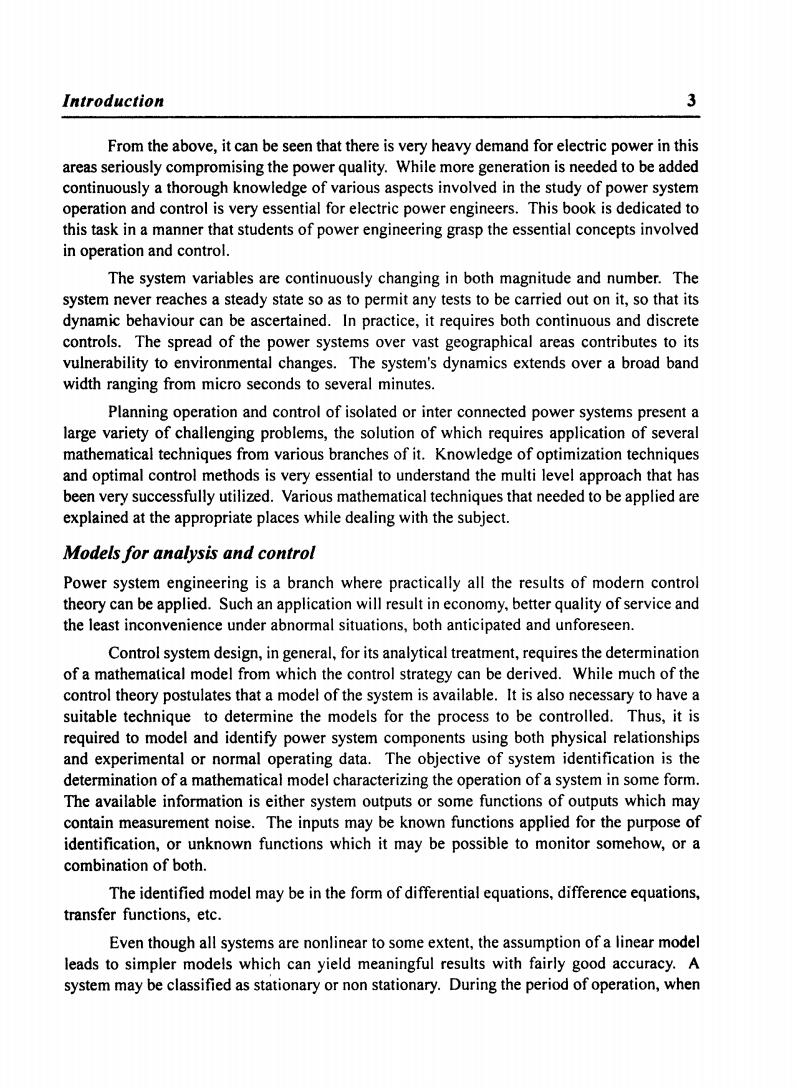
Introduction 3 From the above,it can be seen that there is very heavy demand for electric power in this areas seriously compromising the power quality.While more generation is needed to be added continuously a thorough knowledge of various aspects involved in the study of power system operation and control is very essential for electric power engineers.This book is dedicated to this task in a manner that students of power engineering grasp the essential concepts involved in operation and control. The system variables are continuously changing in both magnitude and number.The system never reaches a steady state so as to permit any tests to be carried out on it,so that its dynamic behaviour can be ascertained.In practice,it requires both continuous and discrete controls.The spread of the power systems over vast geographical areas contributes to its vulnerability to environmental changes.The system's dynamics extends over a broad band width ranging from micro seconds to several minutes. Planning operation and control of isolated or inter connected power systems present a large variety of challenging problems,the solution of which requires application of several mathematical techniques from various branches of it.Knowledge of optimization techniques and optimal control methods is very essential to understand the multi level approach that has been very successfully utilized.Various mathematical techniques that needed to be applied are explained at the appropriate places while dealing with the subject. Models for analysis and control Power system engineering is a branch where practically all the results of modern control theory can be applied.Such an application will result in economy,better quality of service and the least inconvenience under abnormal situations,both anticipated and unforeseen. Control system design,in general,for its analytical treatment,requires the determination of a mathematical model from which the control strategy can be derived.While much of the control theory postulates that a model of the system is available.It is also necessary to have a suitable technique to determine the models for the process to be controlled.Thus,it is required to model and identify power system components using both physical relationships and experimental or normal operating data.The objective of system identification is the determination of a mathematical model characterizing the operation of a system in some form. The available information is either system outputs or some functions of outputs which may contain measurement noise.The inputs may be known functions applied for the purpose of identification,or unknown functions which it may be possible to monitor somehow,or a combination of both. The identified model may be in the form of differential equations,difference equations, transfer functions,etc. Even though all systems are nonlinear to some extent,the assumption of a linear model leads to simpler models which can yield meaningful results with fairly good accuracy.A system may be classified as stationary or non stationary.During the period of operation,when
Introduction 3 From the above, it can be seen that there is very heavy demand for electric power in this areas seriously compromising the power quality. While more generation is needed to be added continuously a thorough knowledge of various aspects involved in the study of power system operation and control is very essential for electric power engineers. This book is dedicated to this task in a manner that students of power engineering grasp the essential concepts involved in operation and control. The system variables are continuously changing in both magnitude and number. The system never reaches a steady state so as to permit any tests to be carried out on it, so that its dynamic behaviour can be ascertained. In practice, it requires both continuous and discrete controls. The spread of the power systems over vast geographical areas contributes to its vulnerability to environmental changes. The system's dynamics extends over a broad band width ranging from micro seconds to several minutes. Planning operation and control of isolated or inter connected power systems present a large variety of challenging problems, the solution of which requires application of several mathematical techniques from various branches of it. Knowledge of optimization techniques and optimal control methods is very essential to understand the multi level approach that has been very successfully utilized. Various mathematical techniques that needed to be applied are explained at the appropriate places while dealing with the subject. Models for analysis and control Power system engineering is a branch where practically all the results of modern control theory can be applied. Such an application will result in economy, better quality of service and the least inconvenience under abnormal situations, both anticipated and unforeseen. Control system design, in general, for its analytical treatment, requires the determination of a mathematical model from which the control strategy can be derived. While much of the control theory postulates that a model of the system is available. It is also necessary to have a suitable technique to determine the models for the process to be controlled. Thus, it is required to model and identify power system components using both physical relationships and experimental or normal operating data. The objective of system identification is the determination of a mathematical model characterizing the operation of a system in some form. The available information is either system outputs or some functions of outputs which may contain measurement noise. The inputs may be known functions applied for the purpose of identification, or unknown functions which it may be possible to monitor somehow, or a combination of both. The identified model may be in the form of differential equations, difference equations, transfer functions, etc. Even though all systems are nonlinear to some extent, the assumption of a linear model leads to simpler models which can yield meaningful results with fairly good accuracy. A system may be classified as stationary or non stationary. During the period of operation, when
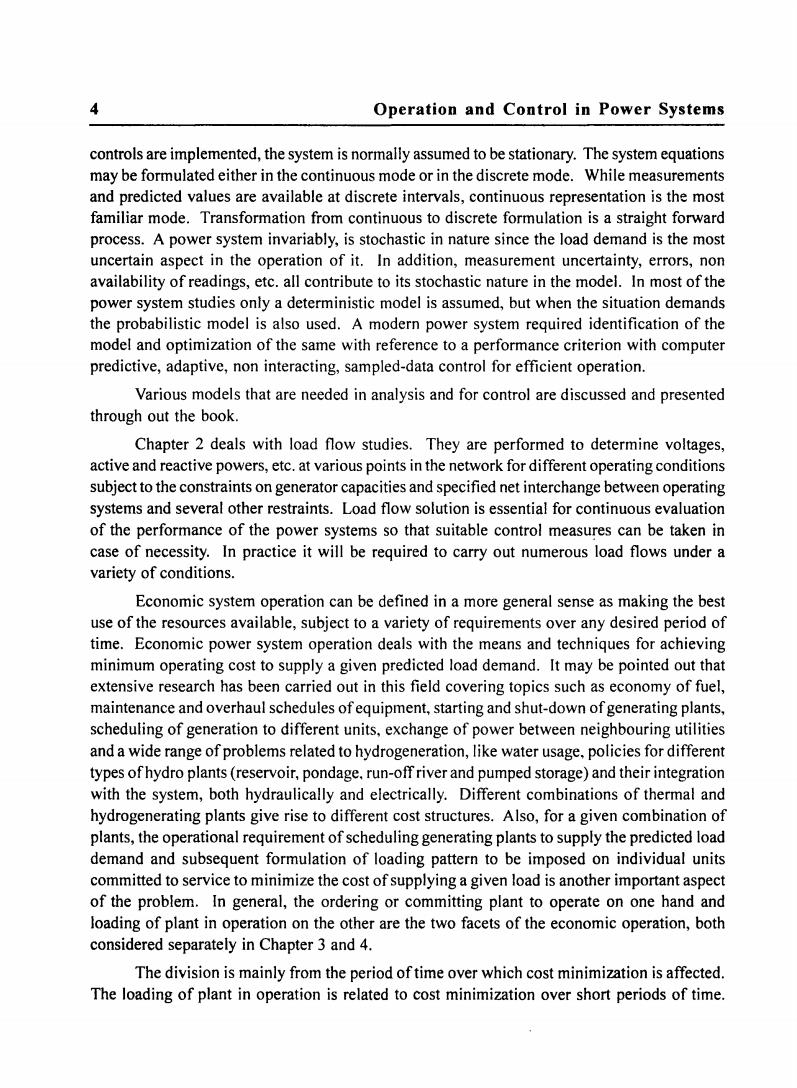
4 Operation and Control in Power Systems controls are implemented,the system is normally assumed to be stationary.The system equations may be formulated either in the continuous mode or in the discrete mode.While measurements and predicted values are available at discrete intervals,continuous representation is the most familiar mode.Transformation from continuous to discrete formulation is a straight forward process.A power system invariably,is stochastic in nature since the load demand is the most uncertain aspect in the operation of it.In addition,measurement uncertainty,errors,non availability of readings,etc.all contribute to its stochastic nature in the model.In most of the power system studies only a deterministic model is assumed,but when the situation demands the probabilistic model is also used.A modern power system required identification of the model and optimization of the same with reference to a performance criterion with computer predictive,adaptive,non interacting,sampled-data control for efficient operation. Various models that are needed in analysis and for control are discussed and presented through out the book. Chapter 2 deals with load flow studies.They are performed to determine voltages, active and reactive powers,etc.at various points in the network for different operating conditions subject to the constraints on generator capacities and specified net interchange between operating systems and several other restraints.Load flow solution is essential for continuous evaluation of the performance of the power systems so that suitable control measures can be taken in case of necessity.In practice it will be required to carry out numerous load flows under a variety of conditions. Economic system operation can be defined in a more general sense as making the best use of the resources available,subject to a variety of requirements over any desired period of time.Economic power system operation deals with the means and techniques for achieving minimum operating cost to supply a given predicted load demand.It may be pointed out that extensive research has been carried out in this field covering topics such as economy of fuel, maintenance and overhaul schedules ofequipment,starting and shut-down of generating plants, scheduling of generation to different units,exchange of power between neighbouring utilities and a wide range of problems related to hydrogeneration,like water usage.policies for different types of hydro plants(reservoir,pondage,run-off river and pumped storage)and their integration with the system,both hydraulically and electrically.Different combinations of thermal and hydrogenerating plants give rise to different cost structures.Also,for a given combination of plants,the operational requirement of scheduling generating plants to supply the predicted load demand and subsequent formulation of loading pattern to be imposed on individual units committed to service to minimize the cost of supplying a given load is another important aspect of the problem.In general,the ordering or committing plant to operate on one hand and loading of plant in operation on the other are the two facets of the economic operation,both considered separately in Chapter 3 and 4. The division is mainly from the period of time over which cost minimization is affected. The loading of plant in operation is related to cost minimization over short periods of time
4 Operation and Control in Power Systems controls are implemented, the system is normally assumed to be stationary. The system equations may be formulated either in the continuous mode or in the discrete mode. While measurements and predicted values are available at discrete intervals, continuous representation is the most familiar mode. Transformation from continuous to discrete formulation is a straight forward process. A power system invariably, is stochastic in nature since the load demand is the most uncertain aspect in the operation of it. In addition, measurement uncertainty, errors, non availability of readings, etc. all contribute to its stochastic nature in the model. In most of the power system studies only a deterministic model is assumed, but when the situation demands the probabilistic model is also used. A modern power system required identification of the model and optimization of the same with reference to a performance criterion with computer predictive, adaptive, non interacting, sampled-data control for efficient operation. Various models that are needed in analysis and for control are discussed and presented through out the book. Chapter 2 deals with load flow studies. They are performed to determine voltages, active and reactive powers, etc. at various points in the network for different operating conditions subject to the constraints on generator capacities and specified net interchange between operating systems and several other restraints. Load flow solution is essential for continuous evaluation of the performance of the power systems so that suitable control measures can be taken in case of necessity. In practice it will be required to carry out numerous load flows under a variety of conditions. Economic system operation can be defined in a more general sense as making the best use of the resources available, subject to a variety of requirements over any desired period of time. Economic power system operation deals with the means and techniques for achieving minimum operating cost to supply a given predicted load demand. It may be pointed out that extensive research has been carried out in this field covering topics such as economy of fuel, maintenance and overhaul schedules of equipment, starting and shut-down of generating plants, scheduling of generation to different units, exchange of power between neighbouring utilities and a wide range of problems related to hydrogeneration, like water usage, policies for different types of hydro plants (reservoir, pondage, run-off river and pumped storage) and their integration with the system, both hydraulically and electrically. Different combinations of thermal and hydrogenerating plants give rise to different cost structures. Also, for a given combination of plants, the operational requirement of scheduling generating plants to supply the predicted load demand and subsequent formulation of loading pattern to be imposed on individual units committed to service to minimize the cost of supplying a given load is another important aspect of the problem. In general, the ordering or committing plant to operate on one hand and loading of plant in operation on the other are the two facets of the economic operation, both considered separately in Chapter 3 and 4. The division is mainly from the period_of time over which cost minimization is affected. The loading of plant in operation'is related to'Cost minimization over short periods of time
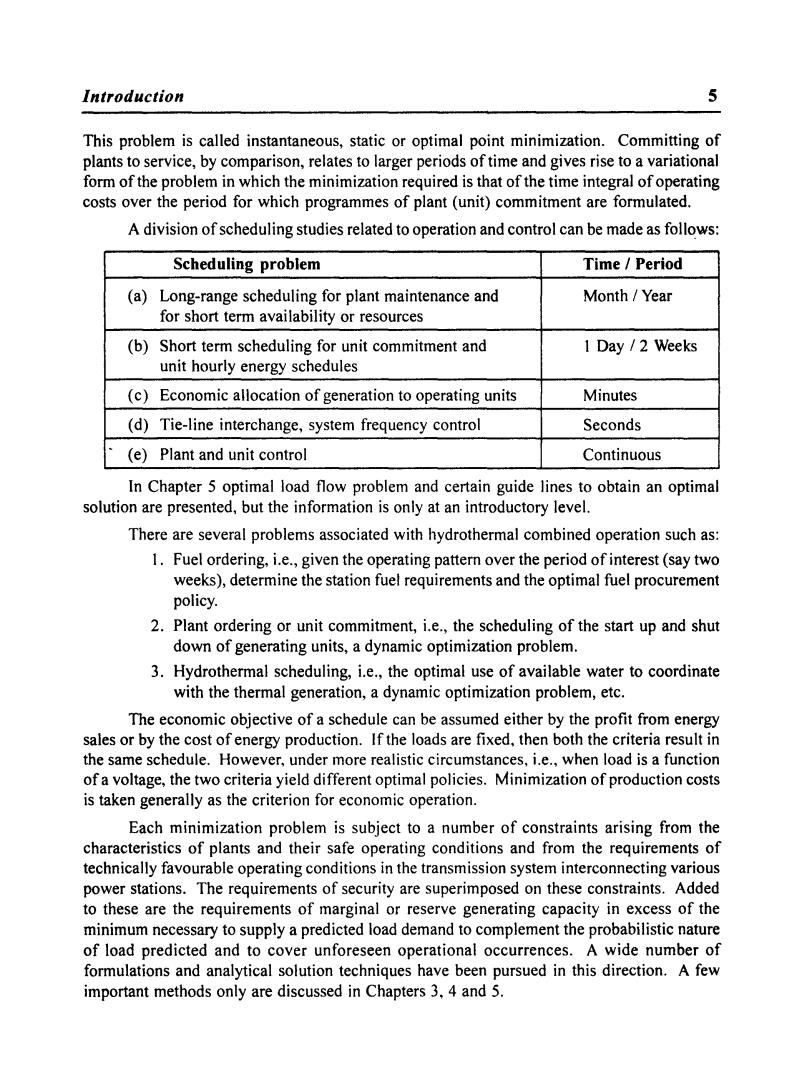
Introduction 5 This problem is called instantaneous,static or optimal point minimization.Committing of plants to service,by comparison,relates to larger periods of time and gives rise to a variational form of the problem in which the minimization required is that of the time integral of operating costs over the period for which programmes of plant (unit)commitment are formulated. A division of scheduling studies related to operation and control can be made as follows: Scheduling problem Time /Period (a)Long-range scheduling for plant maintenance and Month/Year for short term availability or resources (b)Short term scheduling for unit commitment and 1 Day /2 Weeks unit hourly energy schedules (c)Economic allocation of generation to operating units Minutes (d)Tie-line interchange,system frequency control Seconds (e)Plant and unit control Continuous In Chapter 5 optimal load flow problem and certain guide lines to obtain an optimal solution are presented,but the information is only at an introductory level. There are several problems associated with hydrothermal combined operation such as: 1.Fuel ordering,i.e.,given the operating pattern over the period of interest(say two weeks),determine the station fuel requirements and the optimal fuel procurement policy. 2.Plant ordering or unit commitment,i.e.,the scheduling of the start up and shut down of generating units,a dynamic optimization problem. 3.Hydrothermal scheduling,i.e.,the optimal use of available water to coordinate with the thermal generation,a dynamic optimization problem,etc. The economic objective of a schedule can be assumed either by the profit from energy sales or by the cost of energy production.If the loads are fixed,then both the criteria result in the same schedule.However,under more realistic circumstances,i.e.,when load is a function of a voltage,the two criteria yield different optimal policies.Minimization of production costs is taken generally as the criterion for economic operation. Each minimization problem is subject to a number of constraints arising from the characteristics of plants and their safe operating conditions and from the requirements of technically favourable operating conditions in the transmission system interconnecting various power stations.The requirements of security are superimposed on these constraints.Added to these are the requirements of marginal or reserve generating capacity in excess of the minimum necessary to supply a predicted load demand to complement the probabilistic nature of load predicted and to cover unforeseen operational occurrences.A wide number of formulations and analytical solution techniques have been pursued in this direction.A few important methods only are discussed in Chapters 3,4 and 5
Introduction 5 This problem is called instantaneous, static or optimal point minimization. Committing of plants to service, by comparison, relates to larger periods of time and gives rise to a variational form ofthe problem in which the minimization required is that ofthe time integral of operating costs over the period for which programmes of plant (unit) commitment are formulated. A division of scheduling studies related to operation and control can be made as foHows: Scheduling problem Time I Period (a) Long-range scheduling for plant maintenance and Month /Year for short term availability or resources (b) Short term scheduling for unit commitment and I Day / 2 Weeks unit hourly energy schedules (c) Economic allocation of generation to operating units Minutes (d) Tie-line interchange, system frequency control Seconds . (e) Plant and unit control Continuous In Chapter 5 optimal load flow problem and certain guide lines to obtain an optimal solution are presented, but the information is only at an introductory level. There are several problems associated with hydrothermal combined operation such as: 1. Fuel ordering, i.e., given the operating pattern over the period of interest (say two weeks), determine the station fuel requirements and the optimal fuel procurement policy. 2. Plant ordering or unit commitment, i.e., the scheduling of the start up and shut down of generating units, a dynamic optimization problem. 3. Hydrothermal scheduling, i.e., the optimal use of available water to coordinate with the thermal generation, a dynamic optimization problem, etc. The economic objective of a schedule can be assumed either by the profit from energy sales or by the cost of energy production. If the loads are fixed, then both the criteria result in the same schedule. However, under more realistic circumstances, i.e., when load is a function ofa voltage, the two criteria yield different optimal policies. Minimization of production costs is taken generaHy as the criterion for economic operation. Each minimization problem is subject to a number of constraints arising from the characteristics of plants and their safe operating conditions and from the requirements of technically favourable operating conditions in the transmission system interconnecting various power stations. The requirements of security are superimposed on these constraints. Added to these are the requirements of marginal or reserve generating capacity in excess of the minimum necessary to supply a predicted load demand to complement the probabilistic nature of load predicted and to cover unforeseen operational occurrences. A wide number of formulations and analytical solution techniques have been pursued in this direction. A few important methods only are discussed in Chapters 3, 4 and S
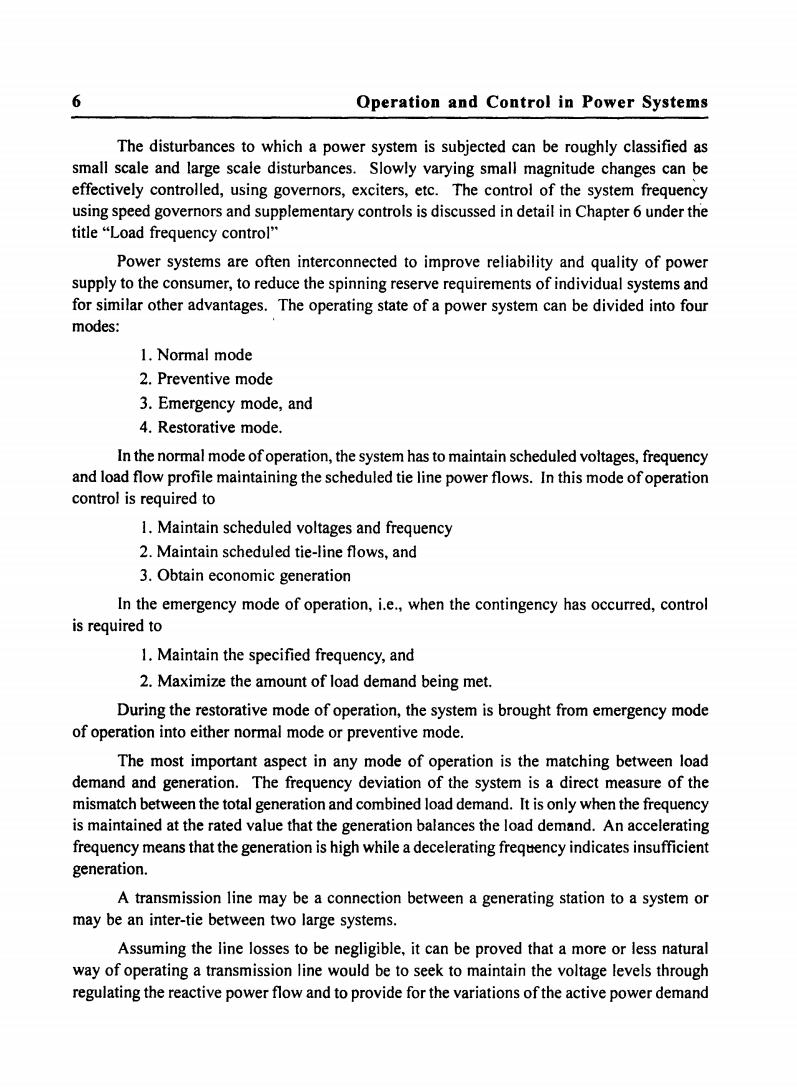
6 Qperation and Control in Power Systems The disturbances to which a power system is subjected can be roughly classified as small scale and large scale disturbances.Slowly varying small magnitude changes can be effectively controlled,using governors,exciters,etc.The control of the system frequency using speed governors and supplementary controls is discussed in detail in Chapter 6 under the title "Load frequency control" Power systems are often interconnected to improve reliability and quality of power supply to the consumer,to reduce the spinning reserve requirements of individual systems and for similar other advantages.The operating state of a power system can be divided into four modes: 1.Normal mode 2.Preventive mode 3.Emergency mode,and 4.Restorative mode. In the normal mode of operation,the system has to maintain scheduled voltages,frequency and load flow profile maintaining the scheduled tie line power flows.In this mode of operation control is required to 1.Maintain scheduled voltages and frequency 2.Maintain scheduled tie-line flows,and 3.Obtain economic generation In the emergency mode of operation,i.e.,when the contingency has occurred,control is required to 1.Maintain the specified frequency,and 2.Maximize the amount of load demand being met. During the restorative mode of operation,the system is brought from emergency mode of operation into either normal mode or preventive mode. The most important aspect in any mode of operation is the matching between load demand and generation.The frequency deviation of the system is a direct measure of the mismatch between the total generation and combined load demand.It is only when the frequency is maintained at the rated value that the generation balances the load demand.An accelerating frequency means that the generation is high while a decelerating frequency indicates insufficient generation. A transmission line may be a connection between a generating station to a system or may be an inter-tie between two large systems. Assuming the line losses to be negligible,it can be proved that a more or less natural way of operating a transmission line would be to seek to maintain the voltage levels through regulating the reactive power flow and to provide for the variations of the active power demand
6 Operation and Control in Power Systems The disturbances to which a power system is subjected can be roughly classified as small scale and large scale disturbances. Slowly varying small magnitude changes can be effectively controlled, using governors, exciters, etc. The control of the system frequency using speed governors and supplementary controls is discussed in detail in Chapter 6 under the title "Load frequency control" Power systems are often interconnected to improve reliability and quality of power supply to the consumer, to reduce the spinning reserve requirements of individual systems and for similar other advantages. The operating state of a power system can be divided into four modes: . 1. Nonnal mode 2. Preventive mode 3. Emergency mode, and 4. Restorative mode. In the nonnal mode of operation, the system has to maintain scheduled voltages, frequency and load flow profile maintaining the scheduled tie line power flows. In this mode of operation control is required to I. Maintain scheduled voltages and frequency 2. Maintain scheduled tie-line flows, and 3. Obtain economic generation In the emergency mode of operation, i.e., when the contingency has occurred, control is required to I. Maintain the specified frequency, and 2. Maximize the amount of load demand being met. During the restorative mode of operation, the system is brought from emergency mode of operation into either nonnal mode or preventive mode. The most important aspect in any mode of operation is the matching between load demand and generation. The frequency deviation of the system is a direct measure of the mismatch between the total generation and combined load demand. It is only when the frequency is maintained at the rated value that the generation balances the load demand. An accelerating frequency means that the generation is high while a decelerating freqttency indicates insufficient generation. A transmission line may be a connection between a generating station to a system or may be an inter-tie between two large systems. Assuming the line losses to be negligible, it can be proved that a more or less natural way of operating a transmission line would be to seek to maintain the voltage levels through regulating the reactive power flow and to provide for the variations of the active power demand